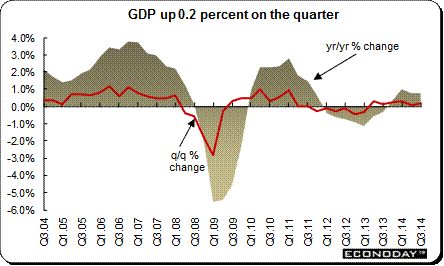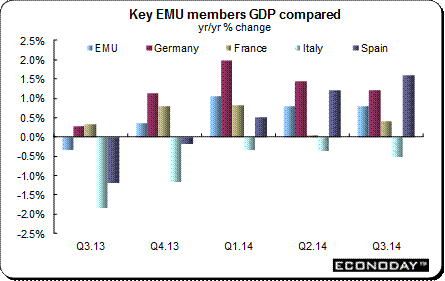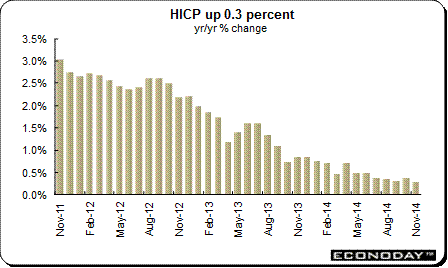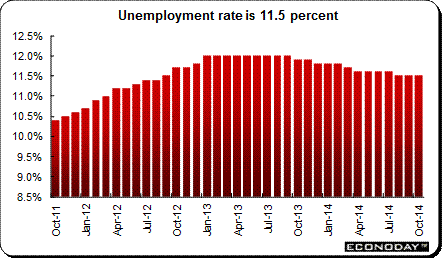
|
Gross domestic product — Growth weakened in 2012 as the sovereign debt crisis took its toll on growth. However, stabilization in the financial markets in 2012 did little to help economic growth. After contracting for six consecutive quarters, second quarter 2013 GDP was up 0.3 percent on the quarter but down 0.6 percent from the same quarter a year ago. However, third quarter GDP edged up only 0.1 percent. GDP continued to contract when compared with the same quarter a year ago, this time by 0.3 percent. GDP was up 0.2 percent in the fourth quarter and increased 0.5 percent from the same quarter a year ago. The Eurozone began 2014 with an increase of 0.2 percent on the quarter. On the year, GDP added 1.0 percent. The Eurozone added a revised 0.1 percent in the second quarter and was up 0.8 percent from a year ago.
Third quarter GDP was up 0.2 percent on the quarter. On the year it added 0.8 percent as it did in the second quarter. Household spending was up 0.5 percent on the quarter, nearly double the previous period's pace and easily its best performance so far in 2014. Fixed investment declined a further 0.3 percent while growth of government consumption was unchanged at 0.3 percent. Inventory accumulation had no impact on the quarterly change in real GDP. Growth would have been somewhat more robust but for a deterioration in net exports which subtracted 0.2 percentage points after having added 0.1 percentage points in the second quarter. The worsening here reflected a 0.8 percent quarterly increase in exports that was more than offset by a 1.2 percent rise in imports.
Among the larger member states, growth in the third quarter was much as expected which means disappointingly sluggish or negative. France surprised with a (less than spectacular) 0.3 percent advance but domestic demand was negative and Germany's total output was up just 0.1 percent. Italy (down 0.1 percent) remained in recession leaving only Spain (0.5 percent) to show any real momentum. Elsewhere growth was typically modest but at least positive apart from Cyprus (down 0.4 percent) which saw yet another quarter of declining output.
Industrial production — Most analysts readily acknowledge that the economy will not function to its fullest potential unless serious structural reforms are undertaken in the labor markets and the financial markets. For example, the industrial sector is the most dominant for the larger countries and the sector is embedded with labor rigidities that present a formidable challenge. Benefit cut backs are not politically expedient. It is difficult to fire employees or to cut back in times of weak growth without paying exorbitant severance and ongoing jobless benefits. These can be so lucrative that the incentive to find another job is non-existent.
Monthly changes in industrial production are volatile. The goods producing sector (excluding construction) rebounded 0.5 percent in September. However, the goods producing sector performed slightly worse than expected in October. Excluding construction, a 0.1 percent monthly increase in output from September but still lifted annual workday adjusted growth from 0.2 percent to 0.7 percent. The headline weakness was somewhat misleading as energy output dived 1.9 percent on the month. Elsewhere performances were rather better although capital goods were off 0.2 percent. Durable consumer goods advanced 0.9 percent, nondurables 1.8 percent and intermediates 0.3 percent. Regionally all of the larger member states struggled — production was flat in Germany and fell 0.1 percent in Italy, 0.4 percent in Spain and 0.9 percent in France. At the same time, the smaller countries painted a very mixed picture.
Inflation — As measured by the harmonized index of consumer prices, inflation soared above the ECB's two percent inflation target. However, prices declined as commodity prices weakened. The ECB's mandate as stated in the Maastricht Treaty that established the Bank is inflation control. This has been interpreted to mean that inflation control has a priority over encouraging growth. However, when the economy contracted, the ECB eased interest rates in conjunction with other central banks worldwide — but lagged both on the size and speed of the cuts. The HICP was above the ECB's 2 percent target from December 2010 to December 2012. However, since January 2013, the HICP dropped below the ECB's target because of weak growth and easing energy prices.
Annual inflation has been under 1.0 percent for the last fourteen months, raising worries of deflation. The softer overall picture of prices is not what the ECB wants to hear and the fact that all member countries saw headline inflation well below target can only make matters more worrisome. However, the ECB has been slow to acknowledge it may have a problem. In July, the flash HICP was up only 0.4 percent on the year after increasing 0.5 percent in June. The ECB acted at its June 5 meeting. However, things have not improved. In September, the HICP was only up 0.3 percent on the year and in October, 0.4 percent. It retreated to 0.3 percent again in November.
Unemployment — Unemployment fluctuated between 8.7 percent and 9 percent during 2004 and in 2005. However, it declined steadily from the summer of 2005 to spring of 2008. Unemployment reached a low of 7.2 percent in February and March of 2008. The unemployment rate increased to 11.7 percent in October 2012 where it remained for the last quarter of 2012 as the economy contracted under the pressures from the sovereign debt crisis. It remained about 12 percent during 2013. In January 2014, the unemployment rate ebbed down to 11.8 and in February 2014 unemployment reached slipped to 11.7 percent where it remained in March. In April, it edged down to a revised 11.6 percent where it remained in May. June's unemployment rate was 11.5 percent. It has remained at 11.5 for the last three months — from August through October.
Merchandise trade — Trade plays an important role in European growth. German and Italian manufacturing sectors especially benefited from the weaker euro and it allowed them to sell their products overseas at reduced prices. Foreign trade had been a major contributor to revived economic growth, especially in Germany where consumer spending tends to lag. Despite the high value of the euro, trade continued to perform well for the most part until August 2008, when the financial crisis along with other effects on the real economy, virtually obliterated world trade. The trade balance was negative from November 2010 until September 2011 when it once again was positive. The balance has been in surplus since November 2011 but mostly on weak imports rather than export growth. Demand continues to be weak within the Eurozone.
|
|||||||
| Legal Notices | ©Copyright 1998-2025 Econoday, Inc. |
powered by
![[Econoday]](images/logo.gif)
![[Apple App Store]](/images/AppleAppStore.png) ![[Econoday on Kindle]](/images/kindle.jpg) 
|
||||||





